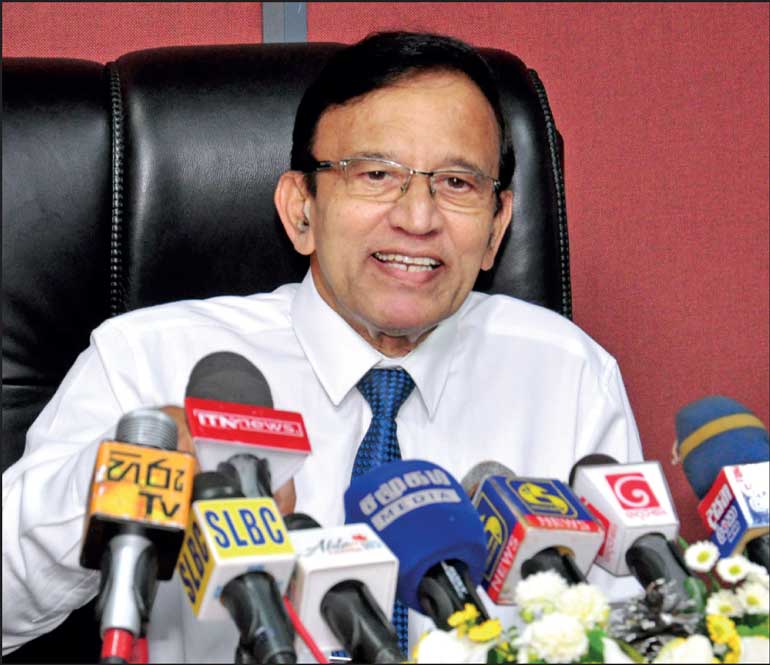Monday Dec 08, 2025
Monday Dec 08, 2025
Wednesday, 28 June 2023 00:00 - - {{hitsCtrl.values.hits}}

EDB Chairman-CEO Dr. Kingsley Bernard
By Charumini de Silva
The Export Development Board (EDB) is likely to complete formulating its comprehensive 5-year National Export Strategy 2023-2027 by next month, to chart the course for Sri Lanka›s export capabilities to $31.3 billion and boost economic growth.
Upon the completion of the strategy, the apex State agency responsible for the development and promotion of exports will also assess if the original $ 18.51 billion in merchandise and service exports for this year need to be revised.
“We have not yet decided on revising the set export target for the year, as the new estimate and focus areas will only be arrived at after taking all aspects into consideration, including the new 5-year NES,” EDB Chairman Dr. Kingsley Bernard told the Daily FT.
The EDB has set a forecast performance of $ 18.51 billion in merchandise and service exports in 2023. This comprises $ 15.93 billion from merchandise exports up from $ 13.01 billion achieved in 2022 and $ 2.58 billion from services exports.
As per EDB’s 2023 forecast, $ 6.5 billion comes from apparel and textile, $ 1.32 billion from tea, $ 1.51 billion from rubber and $ 985 million from coconut-based products. From the other sectors, $ 592 million from food and beverage, $ 585 million from spices and concentrates, $ 490 million from electrical and electronic components and $ 445 million from diamonds, gems and jewellery. Additionally, seafood exports are estimated to bring $ 367 million and $ 582 from petroleum products.
“To prevail over the current economic crisis, we need a leapfrog of 15% average annual growth to boost total exports to $ 31.3 billion by 2027. The merchandise exports need to be doubled from the existing $ 13 billion to $ 26 billion within the next five years,” he said.
He also said the EDB has appointed an internal committee, tasked with formulating the plan without additional funding and the committee is working diligently to complete the strategy›s formulation by the end of next month.
The first NES launched in 2018 was a design and management process led by the Development Strategies and International Trade Ministry along with the EDB, and the International Trade Centre (ITC) provided the technical support within the framework of the European Union -Sri Lanka Trade-Related Assistance project funded by the EU.
Dr. Bernard underscored the commitment to nurturing a resilient and competitive export industry with the forthcoming five-year strategy, coupled with the anticipation of improved performance in the latter part of 2023 and the potential benefits of the UK’s trading preference towards apparel and other industries.
Earlier this month, the UK Government launched one of the most generous sets of trading preferences, the ‘Developing Countries Trading Scheme’ (DCTS) to facilitate developing countries to integrate into the global economy, create stronger trade and investment partnerships and strengthen supply chains. Sri Lanka falls under the type of trading arrangement of ‘Enhanced Preferences’. DCTS will provide duty-free, quota-free trade to LDCs on everything, but arms and duty-free, quota-free trade on 85% of eligible goods to most low-income (LIC) and lower-middle-income (LMIC) countries.
The EDB Chairman expressed confidence that the merchandise exports will regain momentum in the third and fourth quarters of 2023. This positive outlook is attributed, in part, to the DCTS scheme that the United Kingdom has granted to Sri Lanka, which is expected to contribute to the apparel export recovery towards the latter part of 2023.
“Although Sri Lanka's merchandise exports experienced a challenging start, there is optimism for a turnaround in the coming months,” he added.
Dr. Bernard said the EDB is also actively exploring new markets to diversify its export destinations, and one of the key markets being considered is India, which holds significant potential for trade collaboration. However, he noted that the results of these efforts will take some time to materialise, as building relationships and penetrating new markets is a gradual process.
In terms of potential sectors to boost trade, he said organic products, cinnamon and electrical and electronic components (EEC).
“We have potential for organic products and compared to our competitors Sri Lanka is in a good position ahead of the game. Sri Lanka also has true Cinnamon and has got the GI certification too. There are many value additions that can be done in terms of Ceylon Cinnamon,” he explained.
The EEC was also described as a big business that exporters can further explore, as they need not reinvent the wheel to get into the value chain and connect to the value chains at different stages.
“The current economic reform agenda, which aims to transform the country into an open and dynamic trading economy, symbolises a confident nation,” he said, adding that Sri Lanka’s dynamic workforce, combined with structured efforts to stimulate innovation and entrepreneurship can create value in regional and global production networks.